
Kagen Sound
Kagen Sound |
I grew up in Colorado, a mountainous region in the US. I
have always enjoyed working with my hands and using my mind to create
puzzles. I especially like puzzle-boxes because the inside is so mysterious.
Now I make mysterious boxes as my full-time profession. I first met the
Karakuri Creation Group in August 2004, when I visited Tokyo for the IPP
puzzle convention. Their puzzles have been a huge inspiration for me. |
This page is only for explanation of products.
| PRODUCT | ITEM | INFORMATION |
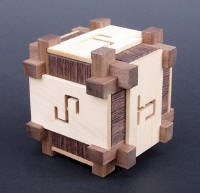 Maze Burr |
KA-14 | Created: 2006 Materials: Wenge, Walnut, and Maple hardwoods Size: 103 x 103 x 103 mm This is a genuine puzzle. We can see all the mechanism, and it’s familiar to play. But, we lost the way soon before we knows. Your goal is to put off the plates. You can move the each plate. But, they are controlled by the maze, and the plates obstruct each other. “It was made by Kagen Schaefer with much help from my sister Robin Schaefer. If you could see the inside mechanism of the Rune Box it would look a lot like the Maze Burr. The mazes on each side all show you the way inside. Sometimes it is only a few moves, sometimes it is more than a hundred moves. When you take apart the Maze Burr, then you can rebuild it differently.” |
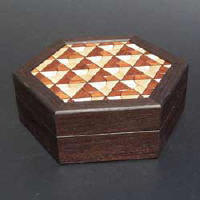
Disc Box |
KA-13 | Made from Wenge, Figured Maple, and Bubinga. 8 cm x 19 cm x 22 cm Each of the 19 rotating discs must be moved in the correct sequence until the triangles all match in color. Then the lid opens up on a hinge. |
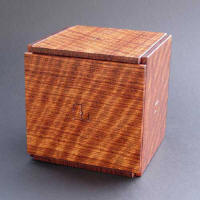 Rune Box |
KA-12 | Made in 2004 Made from Curly Bubinga, Maple, and Paduk 12cm x 12cm x 12cm This box was made as a gift to Karakuri Group. How many moves does it take to open the Rune Box? That depends how many moves you want it to take. The Rune Box has symbols on it that look like ancient rune letters. They are not real runes, but they will tell you how to solve this box if you can read them right. Once the box is open, you can re-arrange the runes into your own sequence. Now it is a new puzzle. |
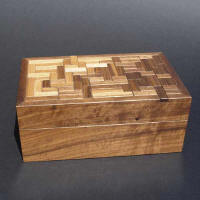 Walnut Block Box |
KA-11 | Made in 2004 Made from Walnut and Maple 21.6cm x 13.3cm x 8.9cm The tiles are all made from different natural shades of walnut from the same board. Start at the dark walnut and go towards the light. From the most difficult starting point, 169 moves are required to unlock The Walnut Block Box. It also has eight different starting positions. |
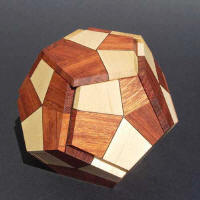 Dodecahedron Box |
KA-10 | Made in 2004. Made from Bubinga, Maple, Wenge. 14cm x 16cm x 16cm. Awarded Grand prize and Peoples choice awards Tokyo IPP. All but two of the pentagons rotate. To unlock the box match up the colors on the outside. When you are at the last move to matching the colors the lid opens on a hinge. The inside is very beautiful. |
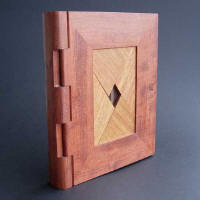 Diamond Book |
KA-9 | Made in 2004. Made from Bubinga, Maple, Wenge. Approx 30cm x 24cm x 3.5cm When you unlock this book the diamond disappears and then reappears in a different color. This is a functional journal for writing. You can even change the paper like a binder. Wooden dowels hold the paper securely inside the book. |
 The Book (1st prototype) |
KA-8 | Made in 2004. approx 23cm x 18cm x 4cm Find the sliding panel to open the book. It is a journal for writing whatever you like. When you want to use new paper, you may replace it too. I like the journal for the same reason I like boxes; you open them and put things inside. |
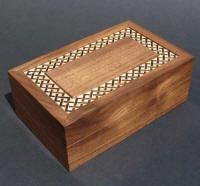 Braided Box |
KA-7 | Made in 2004. Made from Walnut, Maple, Wenge 20.3cm x 12.7cm x 7.6cm A very simple movement unlocks this box. The clue is this. When the Braid is broken, the box will open. |
|
Decorated Box |
KA-6 | Made in 2003 Made from Wenge, Maple, and Walnut. 20.3cm x 12.7cm x 7.6cm Winner of Honorable Mention award Chicago IPP. This works the same way as the Braided Box. |
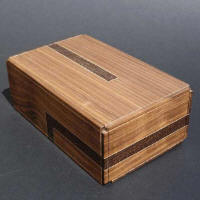 Waterfall Box #3 |
KA-5-3 | Made 2003. Made from Walnut, Wenge, and Maple 20cm x 12.4cm x 7.3cm This is the third box to a series of five boxes. The first four boxes combined will give a clue to solving the fifth box. The Waterfall #3 takes 19 moves to open. Follow the wenge stripe to unlock the box. |
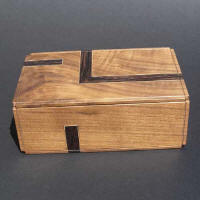 Waterfall Box #2 |
KA-5-2 | Made 2003. Made from Walnut, Wenge, and Maple 20cm x 12.4cm x 7.3cm This is the second box to a series of five boxes. The first four boxes combined will give a clue to solving the fifth box. The Waterfall #2 takes 15 moves to open. Follow the wenge stripe to unlock the box. |
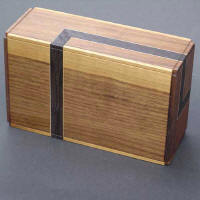 Waterfall Box #1 |
KA-5-1 | Made 2002. Made from Walnut, Wenge, and Maple 20cm x 12.4cm x 7.3cm This is the first box to a series of five boxes. The first four boxes combined will give a clune to solving the fifth box. The Waterfall #1 takes seven moves to open. It is like the 83 Move Box. |
 Block Box |
KA-4 | Made in 2002. Made from Sapele and Maple. 21.6cm x 13.6cm x 8.8 cm Winner of the puzzlers award and first prize IPP Antwerp. To unlock this box you must solve the sliding tile puzzle. A binary system is built into the sliding tiles, so finding the correct sequence is difficult. One can also arrange the tiles four different ways as a starting position. The most difficult position takes eighty moves to unlock. The easiest is only 15 moves. |
The Beast |
KA-3 | Made in 2001. Made from Wenge, Walnut, and Maple. 13 cm x 9cm x 6cm This tiny box takes over eighty moves to open. The 6 outside rectangular faces of the box are all proportional to a golden rectangle. Each side of the box moves up, down, left, and right, but only in the correct sequence. There are no clues to finding the difficult sequence so it takes a long time to open this box. |
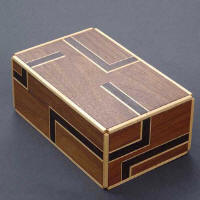 83 Move Box |
KA-2 | Made in 2001 Made from Walnut, Maple, Wenge 20.3cm x 12.7cm x 7.6cm It takes a sequence of 83 moves to open this box. Every side of the box moves left, right, up and down. The stripe traveling around it is a clue to solving it. It is very difficult to open. |
Pinwheel Box |
KA-1 | Made in 2000 Made from Walnut and Maple. 18cm x 18cm x 18cm Each side of the box has a pinwheel. Each pinwheel has a hole in the middle. When all the holes are gone, the box is unlocked. The movement is very different. |
This page is only for explanation of products.